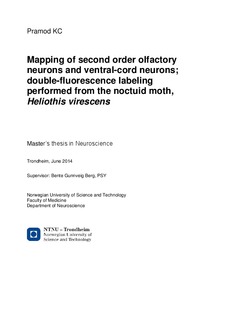| dc.description.abstract | Detection of chemical stimuli from the external environment is performed by all living organisms. Of all senses, the chemical sense is the evolutionary oldest. Also, the neural system devoted to process chemosensory information is strikingly well conserved across the different species, in particular the olfactory pathways. Due to their highly specialized ability of detecting air-born molecules over long distances, plus an accessible nervous system, noctuid moths have served as favorable model organisms for exploring basic neural principles underlying chemosensory information processing. Among the most extensively studied moths, are the heliothines, comprising numerous species distributed in all five continents. Whereas the first and second order levels of the moth olfactory pathway have been relatively thoroughly explored, less is known about the subsequent levels. In particular, the connection between the brain circuit and the motoric system, being positioned in the ventral-cord ganglia, is not described in the current insect group. In this study, fluorescence staining of the axon terminals of the second-order neurons, i.e. antennal-lobe projection neurons, was combined with staining of ventral-cord neurons for the purpose of exploring putative connections between the two neural arrangemnets in the Heliothine moth, Heliothhis virescens. Dye application to the primary olfactory center of the brain, the antennal lobe, showed three major tracts projecting to higher processing regions, mainly to the calyces and the lateral horn, a particular part of the lateral prtocerebrum that is innervated by medial antennal-lobe projection neurons. Labeling of the ventral cord, on the other hand, resulted in visualization of several neuropil regions in the brain, one of which being located in the ventrolateral area of the lateral protocerebrum was of specific interest. Double-labeling experiments performed in the same individual demonstrated, however, that there is no overlap between terminal regions of second-order olfactory neurons processes projecting in the ventral cord, meaning that the main portion of odor information is carried to the ventral cord, not via third order neurons projecting form the lateral horn, but via fourth or higher order neurons orginating in another synaptic region of the brain. | nb_NO |


